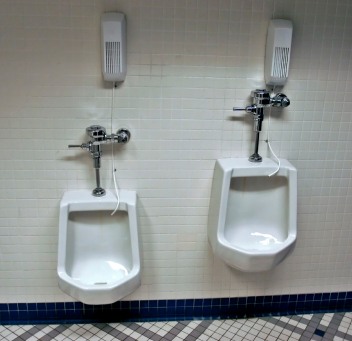A few months ago as I was travelling through LaGuardia airport, I caught site of a fellow traveller with his two hands clicking away on his Blackberry. What looked a bit different was the fact that both his hands were above his head, clicking away on the keyboard as he stared upwards at the device. What was truly bizarre was the fact that he was using the urinal in the men’s room at the same time… “multi-tasking.” Apart from the health and hygiene considerations that make most of us cringe (I figure that his hands had to touch his PDA and some other “P’s” before leaving the men’s room,) he probably was not a surgeon saving a life or a spy planning his escape to Paris, one step ahead of the mysterious guys in black coats. Instead, he was probably trying to save his skin because Morrison in Finance was trying to weasel his way in with the guys in corporate, taking advantage of an absence from the office. Only a well- timed email would thwart that devious strategy. In other words, there was probably no life-threatening emergency at hand, and instead, our PDA-wielding professional was doing what lots of us do — use new technology to ruin our productivity. In the case of multi-tasking, it’s well known that higher productivity comes at the moments when professionals are able to accomplish that elusive state of complete focus described by Mihaly Csikszentmihalyi in his book Flow. According to the author, these are the times when professionals find themselves at their highest points of creativity. He also has found that it takes some 20 minutes to enter this focused mode, and another 20 or so minutes to re-enter it once it’s broken. The professional who checks email every 15 minutes throughout the day is never able to function at anything other than a low state. Neither is the guy who answers his cell phone whenever it rings, and continually checks it for text and voicemail messages. The one who spends an entire meeting checking email also does some damage, as does the person who reads their email and Tweets his buddies while you are talking with them on the phone. In other words, their bad habits ruin their chances of being productive, and the latest technology only makes it easier for them to include others in the destruction. I worked with a telecom company once in the late 1990’s in which everyone had a cell-phone. That was not a problem by itself. Unfortunately, their executives developed a bad habit of answering the device whenever it rang, regardless of what else was happening around them. This meant that in any meeting, anyone could disappear into their cell-phones, even if they happened to be speaking. They’d simply stop in mid-sentence and answer their phone… without knowing who was calling. The effect when they returned was predictable — “What was I saying again?” As a result, meetings would drag, taking twice as long as they required. When it comes to personal productivity, new technology is useful when it’s complemented by sound individual habits. In their absence, technology does create a few things that masquerade as higher productivity. The fact is, you’re not more productive because you can: 1. Listen to music on your iPhone instead of your iPod. 2. Take pictures of your friends with your smartphone instead of your camera 3. Read junk mail on the beach during your vacation in the Bahamas, instead of at work 4. Send email at odd moments in airport rest-rooms, under the guise of “multi-tasking” You might be happier in some strange way (I guess it depends on who is on the receiving end of the email sent at that odd moment) but poor habits are only made worse with the best, well- intentioned technology. I have a feeling that the creators of the Blackberry weren’t thinking to themselves “Let’s distract people so much, that they end up in fatal crashes that provide the punch-line for feature films.” (My apologies to you if you haven’t seen a very popular, recent flick starring Will Smith.) What’s strange to me is that after spending a few hours searching, the only smartphone training I can find on the internet has to do with learning how to use advanced features such as Bluetooth. There is very little to help professionals to develop the habits that can take advantage of these new tools, and actually improve their productivity, rather than destroy it. They are on their own to find ways to invent time management systems that use the right blend of habits and technology that fit their individual circumstances. Checking Blackberry messages at 11pm each night might be a habit that works for you, while all it does for me is earn me the silent treatment of my spouse. Instead, I need to be savvy about the habit-technology blend I employ, and to understand how to craft solutions that meet my daily needs. For most of us, these include being more productive, staying out of trouble and un-learning strange habits we are starting to employ at odd moments.
